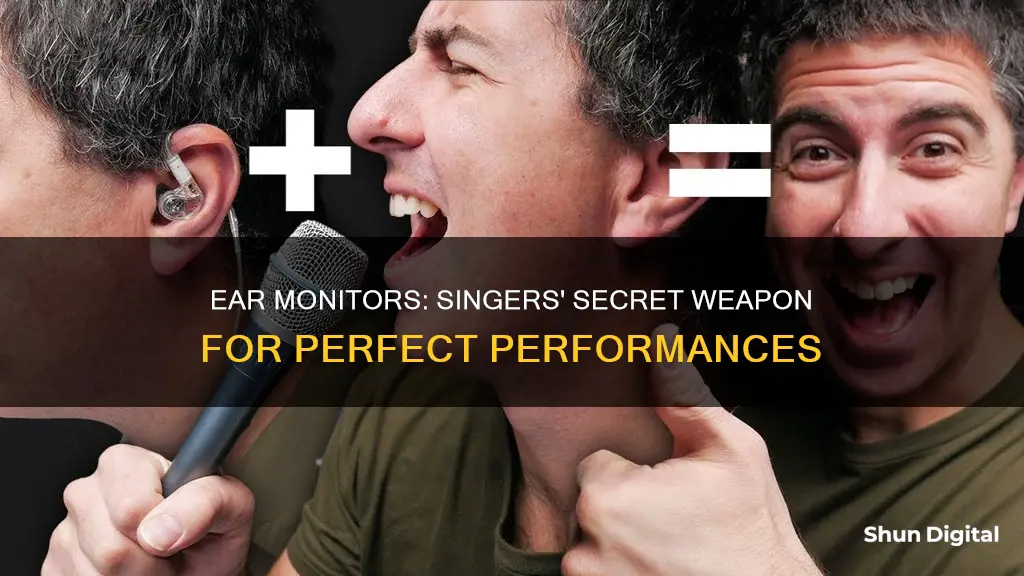
If you've ever been to a live concert, you may have noticed musicians and singers wearing earpieces. These devices are called in-ear monitors (IEMs) and they allow performers to hear what they're singing or playing clearly. In-ear monitors provide a direct source of sound to the musician on stage, blocking out external noise and protecting their hearing. They also allow singers to customise their mix, ensuring they can hear their own voice and stay in time and on pitch.
| Characteristics | Values |
|---|---|
| Purpose | To hear what they are singing or playing clearly |
| Hearing Protection | To protect their hearing from loud volumes |
| Sound Quality | To hear a clear and direct source of sound |
| Mobility | To move around the stage freely |
| Mix Customisation | To hear a mix that suits their needs |
| Reduce Vocal Strain | To prevent vocal strain and potential vocal cord damage |
| Feedback Elimination | To eliminate feedback and provide a clean sound for the audience |
| Portability | To be easily transported |
| Stereo Sound | To adjust the balance of sounds in each ear |
What You'll Learn

To hear their own voice
In-ear monitors (IEMs) are a direct source of sound for singers, allowing them to hear their own voice and performance clearly. When singers perform on stage, they often face the audience and hear sound bouncing off the walls and ceiling of the venue, rather than directly from the speakers. This can make it challenging for them to hear their own voice and perform optimally.
IEMs provide a solution to this issue by delivering sound directly into the performer's ear, ensuring they can hear their voice and performance with clarity. Singers can also adjust their monitor mix, allowing them to hear their voice more prominently in the mix without increasing the overall volume. This is particularly important for singers to stay in pitch and navigate the song effectively. For example, they might need to hear the kick drum clearly to maintain the correct tempo.
IEMs also help to reduce vocal strain. Without IEMs, singers may struggle to hear themselves over the band or the crowd, leading them to sing louder and shout, causing vocal fatigue and potential damage over time. With IEMs, singers can hear themselves clearly and feel less need to strain their voices, resulting in a more accurate and healthy performance.
Additionally, IEMs offer hearing protection for singers, who are at a high risk of developing hearing issues due to frequent exposure to loud environments. By blocking out external noise, IEMs enable singers to hear their mix at a lower and safer volume, reducing the risk of hearing damage.
Blind Spot Collision Monitoring: Kia Telluride EX's Safety Feature
You may want to see also

To block out loud noise
Singers wear ear monitors, or in-ear monitors (IEMs), to block out loud noise.
Performing on stage can be extremely loud, with noise coming from the band, the audience, and the PA system. In-ear monitors are designed to create a seal in the singer's ear, blocking out external noise. This allows the singer to hear their performance without the obstruction of acoustic reflections, helping them to stay on key and on tempo.
The loud noise of a live performance can cause hearing damage, and in-ear monitors are a way to protect the singer's hearing. Musicians are four times more likely to suffer from noise-induced hearing loss and 57% more likely to develop tinnitus. In-ear monitors reduce the risk of hearing damage by blocking out amplified instruments and drums, and allowing the singer to have their mix at a lower level.
In-ear monitors also improve sound quality by blocking out external noise, meaning the singer can hear their mix at a lower volume. This also helps to reduce vocal strain, as singers won't feel the need to shout over the band or audience to hear themselves.
In-ear monitors are a significant improvement on traditional stage wedges, which are large speakers that face the performers. Wedges can cause hearing damage, create clutter on stage, and limit the singer's mobility.
Monitoring Bandwidth Usage on Your iPad: A Step-by-Step Guide
You may want to see also

To protect their hearing
Singers wear ear monitors, also known as in-ear monitors (IEMs), to protect their hearing. Musicians are four times more likely to suffer from noise-induced hearing loss and 57% more likely to develop tinnitus. Any sound over 85 decibels for extended periods can cause hearing damage, and stage volumes can exceed 100 dB. In-ear monitors block out these amplified sounds and protect the wearer's hearing.
In-ear monitors are designed to fit snugly in the performer's ear, creating a seal that blocks out stage volume and the sounds of the crowd. This allows singers to hear a crystal-clear mix at a reasonable volume, reducing the risk of hearing damage.
In-ear monitors also allow singers to isolate their monitor mix from the audience mix. This means they can hear their own voice and specific instruments more clearly, reducing vocal strain and helping them stay on key and on tempo.
Additionally, in-ear monitors can be used with click tracks or metronomes, which help performers stay rhythmically in sync. By delivering these tracks through in-ear monitors, performers can stay in time without the audience hearing the obnoxious ticking of a metronome.
Overall, in-ear monitors are an effective tool for singers to protect their hearing, improve their performance, and reduce the risk of hearing loss.
Midfield Monitor Size Specifications for Your Studio
You may want to see also

To hear a consistent mix
In-ear monitors (IEMs) are a crucial tool for singers to hear a consistent mix while performing. They provide a direct and clear source of sound, allowing singers to hear their performance without obstruction from acoustic reflections. This is especially important as the sound a singer hears from speakers can be warped as it reflects off the walls and ceiling of the venue.
IEMs offer a consistent mix by blocking out external noise and creating a seal in the singer's ear canal. This seal ensures that the sound coming through the monitors goes directly into the ear canal, enabling the singer to hear more detail at a lower volume. This is a significant improvement compared to traditional wedge-shaped floor monitors, which can be too loud and cause hearing damage.
With IEMs, singers can customise their mix to suit their needs. For example, a singer may want their voice to be louder in the mix to ensure they are pitching the notes correctly. IEMs also allow singers to hear their mix consistently, regardless of their position on stage or the venue they are performing in. This is a considerable advantage as the sound a singer hears can vary greatly depending on their location and the acoustics of the room.
IEMs also help singers stay in time with the rest of the band. Singers often rely on hearing one particular element of the arrangement, such as the kick drum, to navigate the song effectively. IEMs allow singers to turn up the volume of certain instruments in their mix, ensuring they always have a clear reference point to stay in time.
Overall, in-ear monitors are essential for singers to hear a consistent mix while performing. They provide a clear and customised sound, block out external noise, and enable singers to hear their mix regardless of their position or the venue.
Monitoring Furnace Usage: A Comprehensive Guide to Tracking Efficiency
You may want to see also

To hear things the audience can't
In-ear monitors (IEMs) allow singers to hear things that the audience can't. This is achieved through a process called 'monitoring', which allows singers to hear their own performance without the obstruction of acoustic reflections.
Singers can also use IEMs to isolate their monitor mix from the audience mix. This means that the audio the audience hears is separate from the audio the singer hears. Earpieces offer a simple solution to this, as the sound is produced directly into the performer's ears.
IEMs also allow singers to isolate their individual monitor mixes from each other. A monitor mix can be balanced to help each performer focus on their part. For example, a singer might want to hear the melody played by the lead guitarist more clearly, so they can ask a mix engineer to turn up the lead guitar in their monitor mix.
IEMs also allow singers to hear things that the audience can't, such as metronomes or backing tracks. Metronomes, or 'click tracks', are an essential tool to help performers stay rhythmically in sync with one another. They are sent to performers in their monitor mixes but are omitted from the audience mix.
Singers can also use IEMs to add audio cues that the audience can't hear, for a more precise performance.
Cleaning Monitors: Removing Fly Specks Completely
You may want to see also
Frequently asked questions
Ear monitors, or in-ear monitors (IEMs), are devices that singers wear to listen to their music while performing. They consist of a transmitter, a receiver, and a pair of earphones. The transmitter sends the audio of the performance to the receiver, which is worn as a belt pack, and the earphones block out unwanted background sounds.
Singers need ear monitors to hear themselves clearly while performing. Without them, singers would hear a warped version of the mix as it reflects off the venue's walls and ceiling. Ear monitors provide a direct and clear source of sound, allowing singers to stay on key and in tempo.
In addition to providing a clear source of sound, ear monitors offer superior sound quality, hearing protection, reduced vocal strain, and increased mobility on stage. They also eliminate feedback and provide a clean sound for the audience.
Ear monitors create a seal against the ear canal, blocking out external noise and allowing the singer to hear a crystal-clear mix at a lower volume. This helps protect the singer's hearing and reduces the risk of vocal damage.
Singers may remove their ear monitors due to technical issues, such as a poor monitor mix or faulty equipment. They may also want to feel more connected to the audience, as ear monitors can make them feel disconnected from the crowd.







